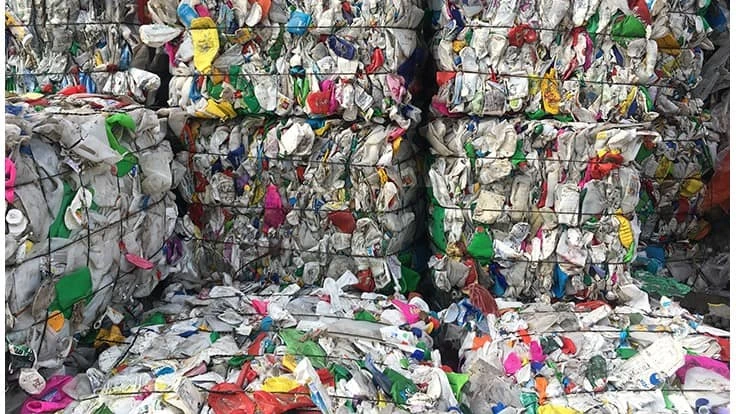
Photo from Recycling Today photo archive
The U.S. Plastics Pact, which lists Walpole, New Hampshire, as its mailing address, has released its "Problematic and Unnecessary Materials List." The list identifies 11 items that are not currently reusable, recyclable or compostable at scale in the U.S. and are not projected to be kept in a closed loop in practice and at scale by 2025.
The organization says the list was developed by U.S. Plastics Pact members—more than 100 businesses, nonprofits and government organizations, or "activators,"—looking to develop guidance on circular alternatives to eliminate the items on the list by 2025.
The U.S. Plastics Pact’s consumer packaged goods, or CPG, retailer and converter activators produce 33 percent of plastic packaging in the U.S. by weight. In 2020, 66 percent of business activators were making individual plans and taking steps to eliminate specific materials, formats and components or to move from nonrecyclable to recyclable package designs, according to the U.S. Plastics Pact.
The U.S. Plastic Pact’s "Problematic and Unnecessary Materials List" is comprised of the following items:
- cutlery provided with prepared packaged food;
- per- and polyfluoroalkyl substances (PFAS) added in packaging;
- nondetectable pigments, such as carbon black;
- opaque or pigmented polyethylene terephthalate (PET) bottles (any color other than transparent blue or green);
- oxo-degradable additives, including oxo-biodegradable additives;
- PETG, or polyethylene terephthalate glycol, in rigid packaging;
- problematic label constructions, including adhesives, inks and materials;
- polystyrene, including expanded polystyrene, or EPS;
- polyvinyl chloride, including polyvinylidene chloride;
- stirrers provided with on-the-go beverages; and
- straws provided with on-the-go beverages.
The list applies exclusively to plastic packaging. Medical plastics used in clinical, hospital and related laboratory and research settings are not included. Definitions used in the criteria are derived from the Ellen MacArthur Foundation Global commitment criteria, which provides the framework for the U.S. Pact.
“The elimination of these problematic and unnecessary materials will enable advancements in circular package design, increase opportunities for recovery and enhance the quality of recycled content available for manufacturers,” says Emily Tipaldo, executive director of the Pact.
The Pact says the materials on the list also met one or more of the following concerns:
- contain hazardous chemicals or creates hazardous conditions that pose a risk to human health or the environment during its manufacturing, recycling or composting process;
- can be avoided (or replaced by a reuse model) while maintaining utility;
- hinder or disrupt the recyclability or compostability of other items; and
- have a high likelihood of being littered or ending up in the natural environment.
While the list was published with the help of the Pact’s members, some critics question the validity of the list and identification process. According to the American Chemistry Council (ACC), Washington, the list lacks a transparent third-party, data-driven and scientific approach and is instead rooted in ideology. The ACC also suggests the list will do the opposite of its intended purpose.
“The list of plastic materials [the Pact] suggests to be eliminated by 2025 will only hinder the acceleration of a circular economy, slow progress toward a lower-carbon future and reduce our ability to use greater amounts of recycled material in plastic packaging,” says Joshua Baca, the vice president of plastics for the ACC.
According to the ACC, recent advancements in recycling technology have made polystyrene among the most recyclable plastics, and the infrastructure needed to more widely recycle polystyrene products is expanding rapidly. Some of these technologies include advanced and mechanical recycling, dissolution, and depolymerization. Importantly, polystyrene is easily sortable and can be recycled by itself or as a feedstock for advanced recycling (i.e., pyrolysis and depolymerization) technologies, along with polyethylene and polypropylene.
Bacca says the Pact’s recommendations are likely to increase food waste, promote several materials with a higher carbon footprint than plastics and do little to achieve the plastics value chain’s sustainability goals. The goals include requiring all plastic packaging to have at least 30 percent recycled plastic by 2030.
Instead, the ACC says it hopes the two will partner together to leverage the ACC’s expertise and the extensive work done to achieve a more circular economy for all materials by scaling the growth of innovative recycling technologies.
Other critics include the Plastics Industry Association, Washington. The organization says the Pact is restricting businesses' choices in packaging.
"It’s a lot easier to make lists than it is to live with the unintended consequences of eliminating certain types of products," says Tony Radoszewski, president and CEO of the association. "Product packaging is designed with specific functions or applications in mind, even if those aren’t immediately obvious to the end customer. Banning products can result in using alternatives that have much greater impact on the environment."
However, the Pact says it stands with the more than 100 businesses, nonprofit and government organizations that did participate and worked together over a year to develop the list. The organization also points out that it lists the sources used to collect its data here.
Latest from Recycling Today
- Aqua Metals secures $1.5M loan, reports operational strides
- AF&PA urges veto of NY bill
- Aluminum Association includes recycling among 2025 policy priorities
- AISI applauds waterways spending bill
- Lux Research questions hydrogen’s transportation role
- Sonoco selling thermoformed, flexible packaging business to Toppan for $1.8B
- ReMA offers Superfund informational reports
- Hyster-Yale commits to US production





